
The Politics of Sea Surgery During the GAoP Menu: 1 2 3 4 5 6 7 8 9 <<First
The Politics of Sea Surgery During the Golden Age of Piracy, Page 9
Micro-Politics: The Pirates' Opinion of the Surgeon
This brings us to the pirates' view of the surgeon on a ship. Like many other facets of piracy, opinions of and rules regarding the surgeon varied from crew to crew and from situation to situation. Pirates generally seemed to have a high regard for the profession. This shouldn't be surprising given the nature of their business and the fact that many of them were often drunk and more likely to have accidents and fights than naval or merchant crews. A surgeon could be crucial to their survival.
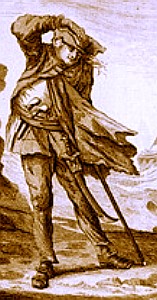
Artist: Joseph Nicholls
Pirate Edward Low (1736)
During the trial of surgeon John Kencate taken with Edward Low's crew in 1723, the Advocate General observed "The Doctor being ador'd among 'em as the Pirates God far in him they chiefly confide far their Cure and Life, and in this Trust and Dependance it is"1. In fairness, the Advocate General was probably overstating his importance in an effort to prevent the jury from being too lenient. Surgeons were usually recognized as forced men and frequently acquitted by juries in piracy trials.
When William Fly's men mutinied aboard the Elizabeth in 1726, they threw the ship's captain and his mate overboard to drown, but they handcuffed the doctor to his bunk.2 When the ship had been captured, the crew "next debated what should be done with the doctor. Some were for sending him to look after the captain and mate [drowning him]; but the majority, as he was a useful man, thought it better to keep him."3 They ended up keeping him, although he must not have proved a very willing addition to the crew because they later let him leave with several other prisoners.4 Still, the majority of the crew on Fly's ship preferred to keep a surgeon rather than kill him. (This wasn't always the case as we shall see.)
Doctor Robert Hunter, a forced surgeon aboard Bartholomew Roberts crew, provides another example of a surgeon receiving leniency from the pirates. Hunter and two other men attempted to escape the pirates, only to be caught. When they were brought back to the ship, the three men "were sentenced to Death, for attempting an Escape from them, and that the other two were really shot for it."5 Whether Hunter's reprieve was a result of his station on the ship isn't clear, but it seems possible since the others were summarily executed.
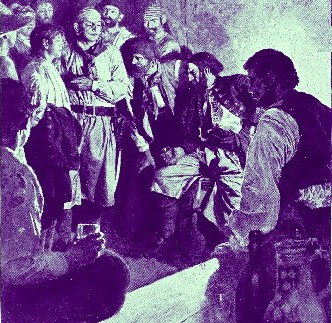
Artist: Howard Pyle (1894)
Another example of the surgeon's importance to the pirates comes from the fact that they often pressed into the pirates' service when they were found on the merchant vessels. Charles Johnson reports that pirate captain Thomas Howard's crew "forced on board carpenters, caulkers, armourers, surgeons, and musicians."6
As a concession to a surgeon, who usually had less use for the pirates than they had for him, surgeons were not normally forced to sign the pirate's articles. This became important if the pirates and their articles were captured; signing the articles was considered one important form of proof that a man was willing to join a pirate crew and therefore likely guilty of piracy.
At his trial, surgeon Kencate attested that "he never shared [plunder] with them [Edward Low's pirates], nor sign'd their Articles"7. Captain Richard Hawkins, reporting on his capture by Francis Spriggs' pirates reported that they had "detain’d on board Mr. Cole Wyeth, the Surgeon" along with the cook from a captured ship, but that "Pyrates do not insist upon these two Persons signing their Articles."8
Another sop to them was the promise to surgeons that they would be released when another surgeon had been captured, (This may also have been due to the notion that if the surgeon was kept against their will too long, 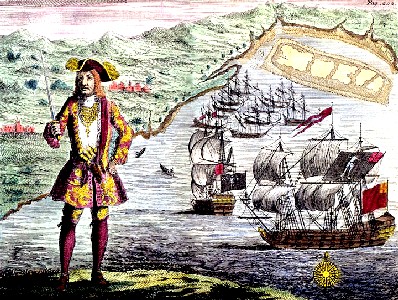
Pirate Bartholomew Roberts and his Ships (1724)
they might not practise their art as conscientiously as the pirates hoped.) Reprobate volunteer pirate surgeon George Wilson told captured surgeon Adam Comrie "that if the Company discharged any Surgeon, he [Wilson]... [would insist] it was his turn, and hoped they would grant it"9. This is curious given how willing Wilson was to join Roberts' crew as we shall see. However it is the an example of the practise of releasing surgeons.
This practise may not have been universal. Dr. Robert Hunter was captured by George Lowther near Bermuda "and forced to serve on the Happy Delivery... for close to a year."10 Surgeon Archibald Murray endured an even longer tenure among the pirates. Murray was captured in the summer of 1718 by Howell Davis off Hispaniola (modern Haiti), serving as surgeon under pirate captains Thomas Cocklyn, Oliver La Bouche, Bartholomew Roberts and William Kennedy - a two year stint! - "till he was finally released at Inveraray Jail."11 It may seem bizarre that someone unwilling to serve the pirates would remain with them for so long. However, as Bridstock Weaver advised fellow captive and surgeon William Parker "as you have run your Hand into the Lyon’s Mouth [by being captured], your best way will be to draw it out again as easily as you can."12
Although the pirates wanted surgeons, it is not clear that they recognized _Wenceslas_Hollar_17th_c.jpg)
Artist: Wencelas Hollar (17th Century)
one surgeon as being better than another. Captain William Snelgrave's surgeon James Bleau benefitted from this when Snelgrave's ship was captured by Davis' and Cocklyn's pirates. The pirates intended to force Bleau to be their surgeon, but, as Snelgrave reports: "a fortunate accident cleared him, when he least expected it; for that very evening, after I was come on Shore, the Surgeon of the French Ship [taken two weeks before Snelgrave's] entered with them; whereupon they gave Mr. Bleau his Liberty the next morning."13
Other pirates showed positive disdain for their surgeon, particularly when he stood in the way of them accomplishing their goals. Surgeon Charles May of the Worcester returned to his ship after purchasing medicines on shore to find a "shambles of bales and chests on the deck and asked [first mate John] Madder, what have you got there, you are full of Business? His enquiry was met with a curse and a command to go mind his Plaister Box."14 Even so, the mutineers kept May on board, likely because they preferred to have a surgeon rather than not have one.
Not all surgeons were so lucky. If mutineers felt that the surgeon would not see their side of it, they dispatched him. When John Gow's pirates mutinied "some of them cut the Throats of the Mate the Doctor and Super Cargoe as they lay in their hammocks, and the Doctor after his Throat was cut came upon Deck and fell down by the Man at the helm and... John Winter threw him over board"15.
There was some interesting examples of how surgeons were treated surgeons on their ships. When a vote was being held among the crews of Oliver Levasseur and John (Richard) Taylor concerning who would stay with pirates and who would seek a pardon, Surgeons Thomas Arrett and Mr. Snear 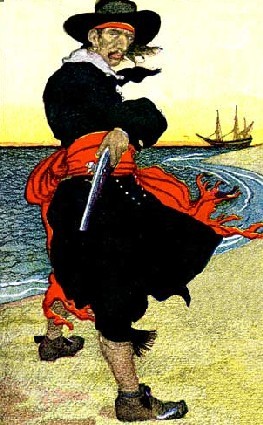
Artist: Howard Pyle (1903) "did not go on board the Guelderland [where the vote was held] by reason that the Surgeons had no Vote there."16 Pirate historian Ed Fox points out that since surgeons were forced men they had no vote. This is somewhat reminiscent of how the Navy made surgeons warrant officers which gave them an officer's title with few of the privileges accorded to commissioned officers.
Surgeons could accrue some benefits by way of respect for their station, however. For example, Bartholomew Roberts' crew held a vote to select the Surgeon of the Company (basically the chief surgeon for Roberts' fleet). When the candidates were being chosen, surgeon George Wilson advised fellow surgeon Adam Comrie "he should be glad if he carry'd it, for a Quarter-share (which they had more than others) would be worth looking after"17. (Comrie and Wilson lost to surgeon Peter Scudamore, which probably disappointed Wilson, but suited forced man Comrie just fine.)
Pirate articles sometimes allowed extra shares to the surgeon, perhaps as a sign of respect for their office. (More likely it was in imitation of the extra shares that surgeons received on privateering voyages.) When the crew of the Camelion slave ship mutinied in 1683, their articles advised: "Now Gentlemen these are to satisfy you, as for the Doctor a Share and half..."18 The idea that extra shares for the doctor were included to satisfy the men is rather interesting by itself. George Lowther's articles ascribed one share a quarter to "The Doctor, Mate, Gunner and Boatswain"19. Edward Low's articles (which are nearly identical to Lowther's, with whom he sailed) read the same way.20
Although the captain was not quite as powerful on a
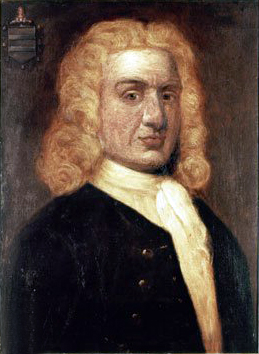
Artist: Sir James Thornhill
Captain William Kidd
(18th century)pirate ship as he was in the Navy or a merchant vessel, he still quite a bit of influence over the ship's surgeon. When Captain William Kidd hit William Moore in the head with a bucket for being insolent to him, it came out at the trial that while surgeon Robert Bradinham was treating Moore he was upbraided by Kidd. Witness Josiah Palmer reported that Kidd said to Bradinham, "You are damn'd busie without Order."21 Despite this, Bradinham continued to treat Moore.
Other surgeons appear to have been on good terms with their pirate captain. As Howell Davis was preparing to plunder Gambia Castle in Africa, he "with the Master and Doctor, dressed themselves like Gentlemen; his Design being, that the Men Should look like common Sailors, and they [three] like Merchants."22 The surgeon (possibly Archibald Murray) may have been forced into the role, although that is not apparent from the account.
At trial, Joseph Trahern testified that disreputable surgeon George Wilson "was very intimate with Roberts, they two using often to say, that if they should meet with any of the Turnip Man's Ships, meaning the King's Ships, they would blow up, and go to Hell together; yet that none of the Pyrates liked him"23. It was also noted at the trial that when Wilson joined Roberts crew, he "borrowed a Shirt and Drawers of the Deponent [surgeon Adam Comrie], saying, he would go on board and see Roberts, and haled the Pyrate as they came under his Stern, calling to Roberts, that he was glad to see him, and would come on board presently"24. You must look good for you future employer. Even Roberts had issues with Wilson and had to assert his authority over him. Roberts "told him [Wilson] in his Presence (on a Complaint from a Man that Wilson would not dress [with bandages]) that he was a double Rogue to be. there a second time, and threaten'd to cut his Ears off, if he had ever a Complaint again."25
Since the pirates were more open to the opinion of the common sailor, they seem to have sometimes allowed the pressed surgeon to turn the tables and assume authority over them. When pirate captain John Halsey's men attacked a Dutch ship of 60 guns, they decided they had taken on more than they could handle. As a result, some went "running down between decks, whom the surgeon
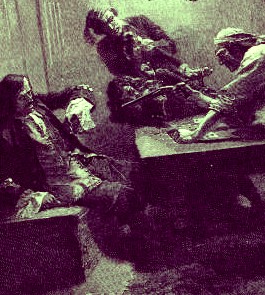
Artist: Howard Pyle (1887)
pricked up again with his sword, though he was no way consenting to their designed piracy."26
Perhaps the most stark example of a surgeon exercising his will occurred in an exchange between Edward Low and one of his surgeons - likely John Kencate [aka. Hincher]27. Low had been accidentally wounded by one of his men
which laid the Teeth bare; upon this the Surgeon was called, who immediately stitched up the Wound, but Low finding fault with the Operation; the Surgeon being tollerably drunk, as it was customary for every Body to be, struck Low such a Blow with his Fist, that broke out all the Stitches, and then bid him sew up his Chops himself and be damned, so that Low made a very pitiful Figure for some Time after.28
There is no record of Low taking any immediate retribution for this exchange, which probably says as much as needs to be said about the relationship between the captain and the surgeon on a pirate ship. However, historian Eric Graham does note that Kencate "was later transferred onto the prize Rebecca which Low had given to his newest recruit, the first mate Harris, as a consort to the Fancy."28
1 “Tryals of Thirty Six Persons for PIRACY", 1723, British Piracy in the Golden Age, Joel Baer, ed., 2007, Volume 3, p. 183; 2 “The Tryals of Sixteen Persons for Piracy &c.”, 1726, p. 22; 3 Captain Charles Johnson, The History of the Pirates, 1829, p. 136; 4 “The Tryals of Sixteen Persons for Piracy &c.”, 1726, p. 20; 5 "Pyrates Lately taken by Captain OGLE", 1723, p. 20; 6 Johnson, History of the Pirates, p. 145; 7 “Tryals of Thirty Six Persons for PIRACY", p. 184; 8 Captain Richard Hawkins, The British Journal, 8/22/1724; 9 "Pyrates Lately taken by Captain OGLE", 1723, p. 43; 10 Eric J. Graham, Seawolves: Pirates & the Scots, 2005, p. 108; 11 Graham, p. 49 & 108; 12 “61. Bridstock Weaver and William Ingram, The Proceedings on the King's Commission of Oyer and Terminer... (London, 1725)", Pirates in Their Own Words, Ed Fox, ed., 2014, p. 327; 13 Captain William Snelgrave, A New Account of Some Parts of Guinea and the Slave Trade, 1734, p. 279; 14 Graham, p. 172; 15 “33. James Williams, from The Examination of James Williams, 27 March, 1725. HCA 1/55 ff. 103-104”, Pirates in Their Own Words, Ed Fox, ed., 2014, p. 162; 16 “44. Richard Moor, from The Examination of Richard Moor, 31 October, 1724. HCA 1/55, ff. 94-97”, Pirates in Their Own Words, Ed Fox, ed., 2014, p. 211; 17 "Pyrates Lately taken by Captain OGLE", 1723, p. 43; 18 "50. Agreement to Commit Piracy. June 30, 1683.", Privateering and Piracy in the Colonial Period Illustrative Documents, John Franklin Jameson, ed., 2009, pp. 160-1; 19 Captain Charles Johnson, A general history of the pirates, 2nd Edition, 1724, p. 352; 20 Boston News-Letter, 8/8/1723; 21 "The Arraignment, Tryal and Condemnation of Captain William Kidd", p. 8; 22 Johnson, General History, p. 181; 23,24,25 "Pyrates Lately taken by Captain OGLE", 1723, p. 43; 26 Johnson, History of the Pirates, p. 97; 27 Graham, p. 109; 28 Johnson, General History, p. 374; 27 Graham, p. 110

